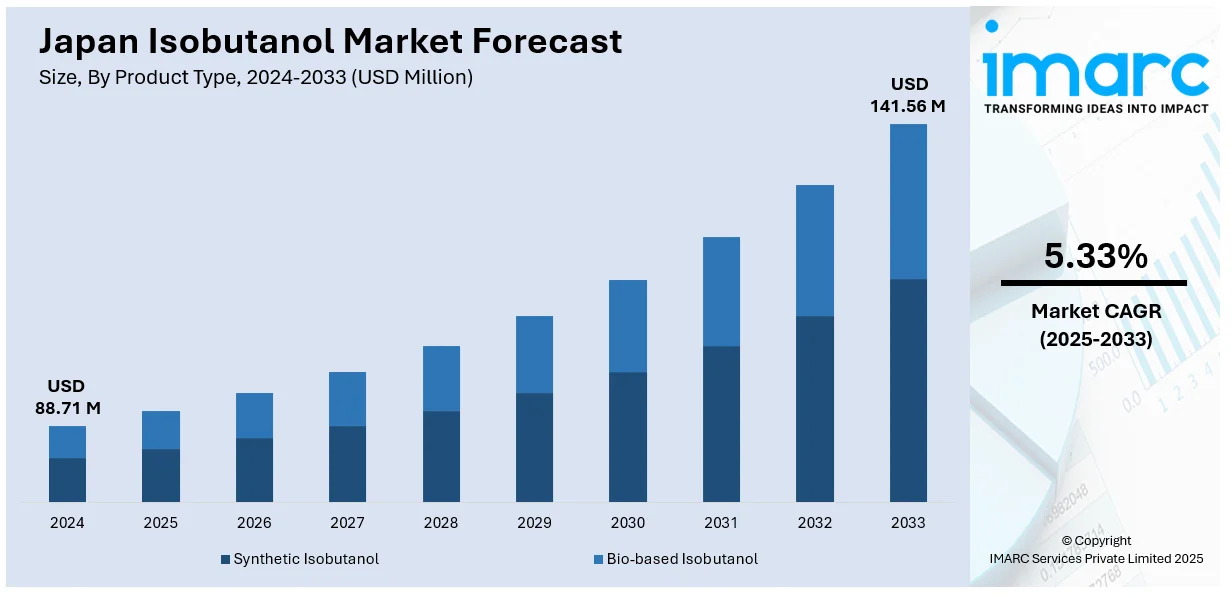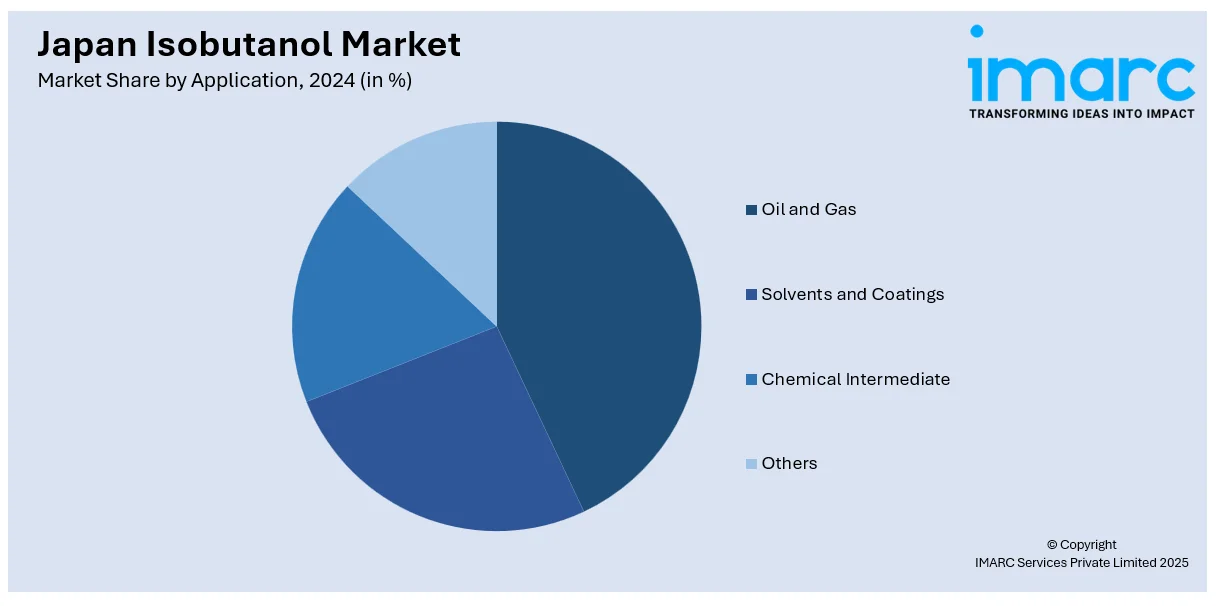
Japan Isobutanol Market Size, Share, Trends and Forecast by Product Type, Application, and Region, 2025-2033
Japan Isobutanol Market Overview:
The Japan isobutanol market size reached USD 88.71 Million in 2024. Looking forward, IMARC Group expects the market to reach USD 141.56 Million by 2033, exhibiting a growth rate (CAGR) of 5.33% during 2025-2033. The escalating demand for automotive coatings, lubricants, and adhesives is positively influencing the market. Besides this, the ongoing trend of miniaturization and high adoption of lightweight electronic designs, which are encouraging manufacturers to employ specialty chemicals that offer high performance without compromising size and weight, is contributing to the expansion of the Japan isobutanol market share.
|
Report Attribute
|
Key Statistics
|
|---|---|
|
Base Year
|
2024 |
|
Forecast Years
|
2025-2033
|
|
Historical Years
|
2019-2024
|
| Market Size in 2024 | USD 88.71 Million |
| Market Forecast in 2033 | USD 141.56 Million |
| Market Growth Rate 2025-2033 | 5.33% |
Japan Isobutanol Market Trends:
Rising vehicle production
Increasing vehicle production is positively influencing the market. As more vehicles are being manufactured, there is a greater need for high-quality paints and coatings to protect surfaces and improve appearance. Isobutanol acts as an important solvent that enhances the performance, durability, and smooth application of these coatings. It also helps improve drying times and provides better resistance to environmental damage. Additionally, the rise in vehicle production is driving the demand for adhesives and sealants used in assembling parts, where isobutanol is a critical ingredient. Japan’s focus on manufacturing high-performance vehicles is encouraging the utilization of premium materials, creating the need for reliable solvents like isobutanol. Manufacturers are seeking consistent and high-quality chemical inputs to meet strict industry standards, and isobutanol helps achieve these goals. As automotive production continues to grow, both domestically and for export, the requirement for chemical items derived from isobutanol is rising, supporting steady market expansion.

Increasing demand for electronic items
Rising demand for electronic items is propelling the Japan isobutanol market growth. Isobutanol serves as an important solvent in the formulation and development of protective coatings that shield delicate electronic components from moisture, dust, and heat, helping to extend the life and reliability of products like smartphones, tablets, computers, and automotive electronics. As Japan remains a worldwide leader in advanced electronics and technology, the industry requires materials that meet strict performance standards. Isobutanol-based chemicals provide excellent stability, flexibility, and durability, which are essential qualities for electronics manufacturing. Additionally, isobutanol supports the production of adhesives used to bond tiny and sensitive parts without damaging the device structure. With the ongoing trend of miniaturization and high adoption of lightweight designs, manufacturers are increasingly depending on specialty chemicals that offer high performance without compromising size and weight. Moreover, the rising focus on smart devices and energy-efficient technologies is driving the demand for sophisticated electronic components, creating the need for isobutanol in different production stages. Innovations in electronics are leading to continuous improvements in material quality, where isobutanol plays a supportive role. Consequently, with the increasing need for high-quality coatings, solvents, adhesives, and chemical intermediates used in the production of electronic devices, the market continues to grow.
Japan Isobutanol Market Segmentation:
IMARC Group provides an analysis of the key trends in each segment of the market, along with forecasts at the country and regional levels for 2025-2033. Our report has categorized the market based on product type and application.
Product Type Insights:
- Synthetic Isobutanol
- Bio-based Isobutanol
The report has provided a detailed breakup and analysis of the market based on the product type. This includes synthetic isobutanol and bio-based isobutanol.
Application Insights:

- Oil and Gas
- Solvents and Coatings
- Chemical Intermediate
- Others
A detailed breakup and analysis of the market based on the application have also been provided in the report. This includes oil and gas, solvents and coatings, chemical intermediate, and others.
Regional Insights:
- Kanto Region
- Kansai/Kinki Region
- Central/ Chubu Region
- Kyushu-Okinawa Region
- Tohoku Region
- Chugoku Region
- Hokkaido Region
- Shikoku Region
The report has also provided a comprehensive analysis of all the major regional markets, which include Kanto Region, Kansai/Kinki Region, Central/ Chubu Region, Kyushu-Okinawa Region, Tohoku Region, Chugoku Region, Hokkaido Region, and Shikoku Region.
Competitive Landscape:
The market research report has also provided a comprehensive analysis of the competitive landscape. Competitive analysis such as market structure, key player positioning, top winning strategies, competitive dashboard, and company evaluation quadrant has been covered in the report. Also, detailed profiles of all major companies have been provided.
Japan Isobutanol Market News:
- In December 2024, Idemitsu Kosan Co. Ltd. awarded a contract to Chiyoda Corp. for vital engineering services related to the operator’s plan to construct a grassroots facility for producing sustainable aviation fuel (SAF) at its Tokuyama petrochemical site in Shunan, Yamaguchi Prefecture, Japan. Alongside the facility, the firm with backing from Japan’s New Energy and Industrial Technology Development Organization’s (NEDO) Green Innovation Fund, planned to implement the alcohol-to-jet (ATJ) technology process utilizing a feedstock of ethanol and other substances like isobutanol intermediate to produce 100,000 kl/year of SAF by 2030 at the operator’s 190,000-b/d integrated Chiba refinery and petrochemical site in Ichihara, Chiba Prefecture, Japan.
- In May 2024, a research team from Japan studied a brief overview of second-generation isobutanol manufacturing via SHF and SSF. This review outlined the prospects of isobutanol as a biofuel, approaches to enhance isobutanol yield, recent experimental research, and advancements in both SHF and SSF utilizing isobutanol-producing strains. It was found that the efficient use of bio-based isobutanol could decrease greenhouse gas emissions. SSF could be a cost-effective method for manufacturing isobutanol, if productivity levels could be improved.
Japan Isobutanol Market Report Coverage:
| Report Features | Details |
|---|---|
| Base Year of the Analysis | 2024 |
| Historical Period | 2019-2024 |
| Forecast Period | 2025-2033 |
| Units | Million USD |
| Scope of the Report | Exploration of Historical Trends and Market Outlook, Industry Catalysts and Challenges, Segment-Wise Historical and Future Market Assessment:
|
| Product Types Covered | Synthetic Isobutanol, Bio-based Isobutanol |
| Applications Covered | Oil and Gas, Solvents and Coatings, Chemical Intermediate, Others |
| Regions Covered | Kanto Region, Kansai/Kinki Region, Central/ Chubu Region, Kyushu-Okinawa Region, Tohoku Region, Chugoku Region, Hokkaido Region, Shikoku Region |
| Customization Scope | 10% Free Customization |
| Post-Sale Analyst Support | 10-12 Weeks |
| Delivery Format | PDF and Excel through Email (We can also provide the editable version of the report in PPT/Word format on special request) |
Key Questions Answered in This Report:
- How has the Japan isobutanol market performed so far and how will it perform in the coming years?
- What is the breakup of the Japan isobutanol market on the basis of product type?
- What is the breakup of the Japan isobutanol market on the basis of application?
- What is the breakup of the Japan isobutanol market on the basis of region?
- What are the various stages in the value chain of the Japan isobutanol market?
- What are the key driving factors and challenges in the Japan isobutanol market?
- What is the structure of the Japan isobutanol market and who are the key players?
- What is the degree of competition in the Japan isobutanol market?
Key Benefits for Stakeholders:
- IMARC’s industry report offers a comprehensive quantitative analysis of various market segments, historical and current market trends, market forecasts, and dynamics of the Japan isobutanol market from 2019-2033.
- The research report provides the latest information on the market drivers, challenges, and opportunities in the Japan isobutanol market.
- Porter's five forces analysis assist stakeholders in assessing the impact of new entrants, competitive rivalry, supplier power, buyer power, and the threat of substitution. It helps stakeholders to analyze the level of competition within the Japan isobutanol industry and its attractiveness.
- Competitive landscape allows stakeholders to understand their competitive environment and provides an insight into the current positions of key players in the market.
Need more help?
- Speak to our experienced analysts for insights on the current market scenarios.
- Include additional segments and countries to customize the report as per your requirement.
- Gain an unparalleled competitive advantage in your domain by understanding how to utilize the report and positively impacting your operations and revenue.
- For further assistance, please connect with our analysts.
 Request Customization
Request Customization
 Speak to an Analyst
Speak to an Analyst
 Request Brochure
Request Brochure
 Inquire Before Buying
Inquire Before Buying




.webp)




.webp)












